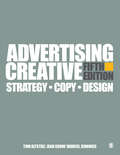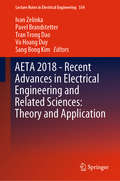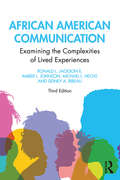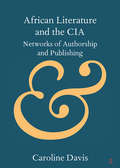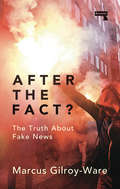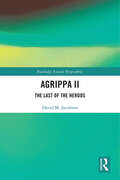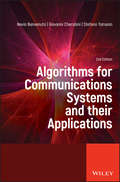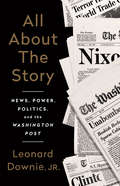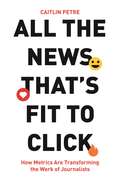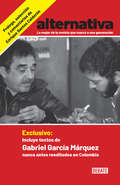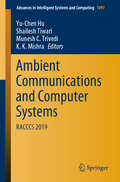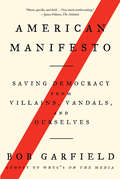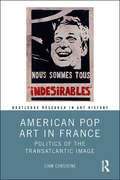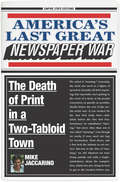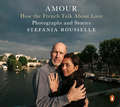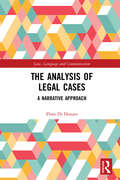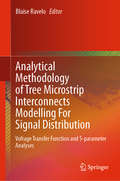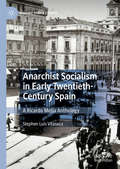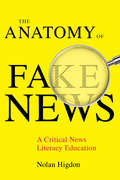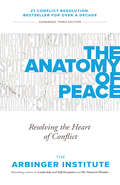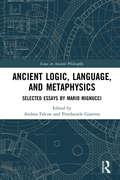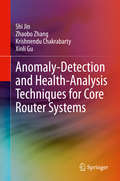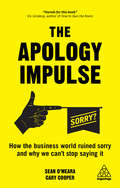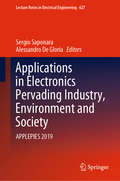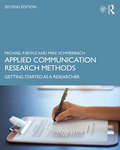- Table View
- List View
Advertising Creative: Strategy, Copy, and Design
by Tom Altstiel Jean M. Grow Marcel JenningsAdvertising Creative, Fifth Edition continues to weave discussions about digital messaging through every chapter. Yet, the underlying theme is still about one thing that never changes—the need for fresh concepts and big ideas in pursuit of the One Thing. This edition introduces a new co-author, Marcel Jennings, who brings a fresh perspective from his background as a copywriter and creative director, as well as teaching at Virginia Commonwealth University. As always, the authors draw upon their experiences as working advertising professionals and teachers to get right to the point, stressing key principles and practical information that students and working professionals can use to communicate more effectively to build memorable brands. They also address some of the key issues impacting our industry today, such as gender equality, diversity in the workplace, and business ethics.
AETA 2018 - Recent Advances in Electrical Engineering and Related Sciences: Theory and Application (Lecture Notes in Electrical Engineering #554)
by Ivan Zelinka Pavel Brandstetter Tran Trong Dao Vo Hoang Duy Sang Bong KimThese proceedings address a broad range of topic areas, including telecommunication, power systems, digital signal processing, robotics, control systems, renewable energy, power electronics, soft computing and more. Today’s world is based on vitally important technologies that combine e.g. electronics, cybernetics, computer science, telecommunication, and physics. However, since the advent of these technologies, we have been confronted with numerous technological challenges such as finding optimal solutions to various problems regarding controlling technologies, signal processing, power source design, robotics, etc. Readers will find papers on these and other topics, which share fresh ideas and provide state-of-the-art overviews. They will also benefit practitioners, who can easily apply the issues discussed here to solve real-life problems in their own work. Accordingly, the proceedings offer a valuable resource for all scientists and engineers pursuing research and applications in the above-mentioned fields.
African American Communication: Examining the Complexities of Lived Experiences (Routledge Communication Series #Vol. 2)
by Ronald L. Jackson II Amber L. Johnson Michael L. Hecht Sidney A. RibeauNow in its third edition, this text examines how African Americans personally and culturally define themselves and how that definition informs their communication habits, practices, and norms. This edition includes new chapters that highlight discussions of gender and sexuality, intersectional differences, contemporary social movements, and digital and mediated communication. The book is ideally suited for advanced students and scholars in intercultural communication, interpersonal communication, communication theory, African American/Black studies, gender studies, and family studies.
African Literature and the CIA: Networks of Authorship and Publishing (Elements in Publishing and Book Culture)
by Caroline DavisDuring the period of decolonisation in Africa, the CIA subsidised a number of African authors, editors and publishers as part of its anti-communist covert propaganda strategy. Managed by two front organisations, the Congress of Cultural Freedom and the Farfield Foundation, its Africa programme stretched across the continent, with hubs in Ibadan, Kampala, Nairobi, Cape Town and Johannesburg. This Element unravels the hidden networks and associations underpinning African literary publishing in the 1960s; it investigates the success of the CIA in disrupting and infiltrating African literary magazines and publishing firms, and determines the extent to which new circuits of cultural and literary power emerged. Based on new archival evidence relating to the Transcription Centre, The Classic and The New African, it includes case studies of Wole Soyinka, Nat Nakasa and Bessie Head, which assess how their literary careers were influenced by these transnational literary institutions, and their response to these interventions.
After the Fact?: The Truth about Fake News
by Marcus Gilroy-WareWhy do we no longer trust facts, experts and statistics? In this essential guide to the turbulent times in which we live, Marcus Gilroy-Ware investigates our era of post-truths and fake news and answers the question of where we can go from here.We are supposed to have more information at our disposal now than at any time in history. So why, in a world of rising sea levels, populist leaders, resurgent fascism and a global pandemic, do so many people believe bizarre and untrue things about the world we live in? In After the Fact?, Marcus Gilroy-Ware shows us what really created the conditions for mis- and disinformation, from fake news and conspiracy theories, to bullshit journalism and the resurgence of the far-right, and why liberal newspaper columnists and centrist politicians are unable to turn back this tide. Spanning politics, culture, psychology, journalism, and much more, After the Fact? is a timely wake-up call for those who believe we can simply go "back to normal", and instead argues that, if we are to put an end to "fake news" we must deal with the broader social crises that are responsible for it.
Agrippa II: The Last of the Herods (Routledge Ancient Biographies)
by David JacobsonAgrippa II is the first comprehensive biography of the last descendant of Herod the Great to rule as a client king of Rome. Agrippa was the last king to assume responsibility for the management of the Temple in Jerusalem, and he ultimately saw its destruction in the Judaean-Roman War. This study documents his life from a childhood spent at the Imperial court in Rome and rise to the position of client king of Rome under Claudius and Nero. It examines his role in the War during which he sided with Rome, and offers fresh insights into his failure to intervene to prevent the destruction of Jerusalem and its Sanctuary, as well as reviewing Agrippa’s encounter with nascent Christianity through his famous interview with the Apostle Paul. Also addressed is the vexed question of the obscurity into which Agrippa II has fallen, in sharp contrast with his sister Berenice, whose intimate relationship with Titus, the heir to the Roman throne, has fired the imagination of writers through the ages. This study also includes appendices surveying the coins issued in the name of Agrippa II and the inscriptions from his reign. This volume will appeal to anyone studying Judaean-Roman relations and the Judaean-Roman War, as well as those working more broadly on Roman client kingship, and Rome’s eastern provinces. It covers topics that continue to attract general interest as well as stirring current scholarly debate.
Algorithms for Communications Systems and their Applications
by Nevio Benvenuto Giovanni Cherubini Stefano TomasinThis welcome second edition to the 2002 original presents the logical arithmetical or computational procedures within communications systems that will ensure the solution to various problems. The authors comprehensively introduce the theoretical elements which are at the basis of the field of algorithms for communications systems. Various applications of these algorithms are then illustrated with a focus on wired and wireless network access technologies. The updated applications will focus on 5G standards, and new material will include MIMO systems (Space-time block coding / Spatial multiplexing / Beamforming and interference management / Channel Estimation /mmWave Model); OFDM and SC-FDMA (Synchronization / Resource allocation (bit and power loading) / Filtered OFDM); Full Duplex Systems (Digital interference cancellation techniques).
All About the Story: News, Power, Politics, and the Washington Post
by Leonard Downie JrAt a time when the role of journalism is especially critical, the former executive editor of the Washington Post writes about his nearly fifty years at the newspaper and the importance of getting at the truth.In 1964, as a twenty-two-year-old Ohio State graduate with working-class Cleveland roots and a family to support, Len Downie landed an internship with the Washington Post. He would become a pioneering investigative reporter, news editor, foreign correspondent, and managing editor, before succeeding the legendary Ben Bradlee as executive editor.Downie's leadership style differed from Bradlee's, but he played an equally important role over more than four decades in making the Post one of the world's leading news organizations. He was one of the editors on the historic Watergate story and drove coverage of the impeachment of President Bill Clinton. He wrestled with the Unabomber's threat to kill more people unless the Post published a rambling 30,000-word manifesto and he published important national security stories in defiance of presidents and top officials. He managed the Post's ascendency to the pinnacle of influence, circulation, and profitability, producing prizewinning investigative reporting with deep impact on American life, before the digital transformation of news media threatened the Post's future.At a dangerous time, when health and economic crises and partisanship are challenging the news media, Downie's judgment, fairness, and commitment to truth will inspire anyone who wants to know how journalism, at its best, works.
All the News That’s Fit to Click: How Metrics Are Transforming the Work of Journalists
by Caitlin PetreFrom the New York Times to Gawker, a behind-the-scenes look at how performance analytics are transforming journalism today—and how they might remake other professions tomorrowJournalists today are inundated with data about which stories attract the most clicks, likes, comments, and shares. These metrics influence what stories are written, how news is promoted, and even which journalists get hired and fired. Do metrics make journalists more accountable to the public? Or are these data tools the contemporary equivalent of a stopwatch wielded by a factory boss, worsening newsroom working conditions and journalism quality? In All the News That's Fit to Click, Caitlin Petre takes readers behind the scenes at the New York Times, Gawker, and the prominent news analytics company Chartbeat to explore how performance metrics are transforming the work of journalism.Petre describes how digital metrics are a powerful but insidious new form of managerial surveillance and discipline. Real-time analytics tools are designed to win the trust and loyalty of wary journalists by mimicking key features of addictive games, including immersive displays, instant feedback, and constantly updated “scores” and rankings. Many journalists get hooked on metrics—and pressure themselves to work ever harder to boost their numbers.Yet this is not a simple story of managerial domination. Contrary to the typical perception of metrics as inevitably disempowering, Petre shows how some journalists leverage metrics to their advantage, using them to advocate for their professional worth and autonomy.An eye-opening account of data-driven journalism, All the News That's Fit to Click is also an important preview of how the metrics revolution may transform other professions.
Alternativa
by Varios AutoresEnrique Santos Calderón selecciona los mejores artículos, reportajes, caricaturas, portadas, editoriales, columnas y entrevistas, de la revista que cambió la forma de hacer periodismo en Colombia La revista Alternativa fue fundada a comienzos de los años setenta por Gabriel García Márquez y Enrique Santos Calderón, entre otros. Con su aparición, se dio forma a un periodismo comprometido y militante que poco se conocía en Colombia. Este libro es un homenaje a la revista y con la selección y comentarios de Enrique Santos Calderón, quien fue su director, se presenta un intenso retrato del país que siguió al Frente Nacional, de los conflictos que asomaron en esa época y que heredamos en el presente. La publicación congregó a un grupo conformado por Orlando Fals Borda, Bernardo García, Antonio Caballero, Daniel Samper Pizano, Álvaro Tirado Mejía y varios más que influirían de manera significativa en la opinión pública colombiana. De tal suerte, la selección que aquí presentamos es la reunión de verdaderas joyas. A los textos del Nobel, muchos de ellos por primera vez reeditados en el país, se sumaron, por ejemplo, entrevistas exclusivas a Botero, Cortázar y Dalí; perfiles de León de Greiff, Capax y Ardila Lülle; la crónica del paro nacional de 1977 o las revelaciones del fiscal que llevó el caso del asesinato de Gaitán. Una Colombia extensa, profunda y diversa, que reclamaba cambios de fondo reaparece en estas páginas, como un espejo del momento actual.
Ambient Communications and Computer Systems: RACCCS 2019 (Advances in Intelligent Systems and Computing #1097)
by Yu-Chen Hu Shailesh Tiwari Munesh C. Trivedi K. K. MishraThis book features high-quality, peer-reviewed papers from the International Conference on Recent Advancement in Computer, Communication and Computational Sciences (RACCCS 2019), held at Aryabhatta College of Engineering & Research Center, Ajmer, India, on August 16–17, 2019. Presenting the latest developments and technical solutions in computational sciences, it covers a variety of topics, such as intelligent hardware and software design, advanced communications, intelligent computing technologies, advanced software engineering, the web and informatics, and intelligent image processing. As such it helps those in the computer industry and academia to use the advances in next-generation communication and computational technology to shape real-world applications.
American Manifesto: Saving Democracy from Villains, Vandals, and Ourselves
by Bob GarfieldDo you fear for our democracy? Are you perplexed by Trumpism? Are you ready to throw in the towel? Don’t! This is your guidebook to reassembling our hyperpolarized American society in six (not–so–easy) steps, written by cohost of WNYC's On the Media Bob GarfieldAs is often observed, Trump is a symptom of a virus that has been incubating for at least fifty years. But not often observed is where the virus is imbedded: in the psychic core of our identity. In American Manifesto: Saving Democracy from Villains, Vandals, and Ourselves, popular media personality Bob Garfield examines the tragic confluence of the American preoccupation with identity and the catastrophic disintegration of the mass media. Garfield investigates how we’ve gotten to this moment when our identity is threatened by both the left and the right, when e pluribus unum is no longer a source of national pride, and why, when looking through this lens of identity, the rise of Trumpism is no surprise. Overlaying this crisis is the rise of the Facebook–Google duopoly and the filter bubble of social media, where identity is insular and immutable.But fear not! WNYC’s On the Media cohost Garfield has ideas about how we may counter the forces of fragmentation—the manifesto itself: six steps to take to reassemble our fractured society. A quick, fascinating read, American Manifesto offers not only a vision of a country in extremis, but also a plan for how to address the ways in which our democracy is imperiled. Provocative, profound, and sometimes hilariously profane, American Manifesto is a call to action like no other.
American Pop Art in France: Politics of the Transatlantic Image (Routledge Research in Art History)
by Liam ConsidinePop art was essential to the Americanization of global art in the 1960s, yet it engendered resistance and adaptation abroad in equal measure, especially in Paris. From the end of the Algerian War of Independence and the opening of Ileana Sonnabend’s gallery for American Pop art in Paris in 1962, to the silkscreen poster workshops of May ’68, this book examines critical adaptations of Pop motifs and pictorial devices across French painting, graphic design, cinema and protest aesthetics. Liam Considine argues that the transatlantic dispersion of Pop art gave rise to a new politics of the image that challenged Americanization and prefigured the critiques and contradictions of May ’68.
America's Last Great Newspaper War: The Death of Print in a Two-Tabloid Town
by America’s Last G Mike JaccarinoA from-the-trenches view of New York Daily News and New York Post runners and photographers as they stop at nothing to break the story and squash their tabloid arch-rivals.When author Mike Jaccarino was offered a job at the Daily News in 2006, he was asked a single question: “Kid, what are you going to do to help us beat the Post?” That was the year things went sideways at the News, when the New York Post surpassed its nemesis in circulation for the first time in the history of both papers. Tasked with one job—crush the Post—Jaccarino here provides the behind-the-scenes story of how the runners and shooters on both sides would do anything and everything to get the scoop before their opponents.The New York Daily News and the New York Post have long been the Hatfields and McCoys of American media: two warring tabloids in a town big enough for only one of them. As digital news rendered print journalism obsolete, the fight to survive in NYC became an epic, Darwinian battle. In America’s Last Great Newspaper War, Jaccarino exposes the untold story of this tabloid death match of such ferocity and obsession its like has not occurred since Pulitzer– Hearst.Told through the eyes of hungry “runners” (field reporters) and “shooters” (photographers) who would employ phony police lights to overcome traffic, Mike Jaccarino’s memoir unmasks the do-whatever-it-takes era of reporting—where the ends justified the means and nothing was off-limits. His no-holds-barred account describes sneaking into hospitals, months-long stakeouts, infiltrating John Gotti’s crypt, bidding wars for scoops, high-speed car chases with Hillary Clinton, O.J. Simpson, and the baby mama of a philandering congressman—all to get that coveted front-page story.Today, few runners and shooters remain on the street. Their age and exploits are as bygone as the News–Post war and American newspapers, generally. Where armies once battled, often no one is covering the story at all.Funding for this book was provided by: Furthermore: a program of the J. M. Kaplan Fund
Amour: How the French Talk About Love--Photographs and Stories
by Stefania RousselleFrom award-winning journalist and filmmaker Stefania Rousselle, a stunning collection of photographs and essays that seek to understand the universality of love Journalist and filmmaker Stefania Rousselle found herself overwhelmed and dejected with the horrors of the news after covering terrorist attacks, human trafficking, and the rise of extremism. To renew her faith in humanity, she took off on a solo road trip across France, determined to see if love still exists. Traveling from village to village, farming towns to industrial cities, heart to heart, Rousselle sought out ordinary women and men, all to ask them one question, What is love?Collecting more than 90 personal testimonies, each one moving and beautiful in its own way, alongside over 100 intimate photographs, Rousselle reveals the many facets of love, and discovers that love can still be found even in the darkest of places. From a baker in Normandy to a shepherd in the Pyrenees, from a tree trimmer in Martinique to a mail woman in the Alps, Amour is a visual testament to love in all its many forms.
The Analysis of Legal Cases: A Narrative Approach (Law, Language and Communication)
by Flora Di DonatoThis book examines the roles played by narrative and culture in the construction of legal cases and their resolution. It is articulated in two parts. Part I recalls epistemological turns in legal thinking as it moves from theory to practice in order to show how facts are constructed within the legal process. By combining interdisciplinary paradigms and methods, the work analyses the evolution of facts from their expression by the client to their translation within the lawyer-client relationship and the subsequent decision of the judge, focusing on the dynamic activity of narrative constuction among the key actors: client, lawyer and judge. Part II expands the scientific framework toward a law-and-culture-oriented perspective, illustrating how legal stories come about in the fabric of the authentic dimensions of everyday life. The book stresses the capacity of laypeople, who in this activity are equated with clients, to shape the law, dealing not just with formal rules, but also with implicit or customary rules, in given contexts. By including the illustration of cases concerning vulnerable clients, it lays the foundations for developing a socio-clinical research programme, whose aims including enabling lay and expert actors to meet for the purposes of improving forms of collective narrations and generating more just legal systems.
Analytical Methodology of Tree Microstrip Interconnects Modelling For Signal Distribution: Voltage Transfer Function and S-parameter Analyses
by Blaise RaveloThis book focuses on the modelling methodology of microstrip interconnects, discussing various structures of single-input multiple-output (SIMO) tree interconnects for signal integrity (SI) engineering. Further, it describes lumped and distributed transmission line elements based on single-input single-output (SIMO) models of symmetric and asymmetric trees, and investigates more complicated phenomenon, such as interbranch coupling. The modelling approaches are based on the analytical methods using the Z-, Y- and T-matrices. The established method enables the S-parameters and voltage transfer function of SIMO tree to be determined. Providing illustrative results with frequency and time domain analyses for each tree interconnect structure, the book is a valuable resource for researchers, engineers, and graduate students in fields of analogue, RF/microwave, digital and mixed circuit design, SI and manufacturing engineering.
Anarchist Socialism in Early Twentieth-Century Spain: A Ricardo Mella Anthology (Hispanic Urban Studies)
by Stephen Luis VilasecaAnarchist Socialism in Early 20th Century Spain is the first English translation of and critical introduction to Ideario, a collection of newspaper and journal articles written by Spanish anarchist Ricardo Mella. Given that Mella is virtually unknown to the English-speaking world, this book provides readers access to his extensive body of work about Spain, human nature, and a world increasingly dominated by capitalism. Suitable for both the general public interested in learning more about anarchist ideas and for scholars studying twentieth-century Spain, the three introductory essays help to introduce Mella, ground his work in the context of Spanish anarchism, and draw connections between Mella and the urban in late nineteenth- and early twentieth-century Spain. Stephen Luis Vilaseca’s translation is accessible and engaging.
The Anatomy of Fake News: A Critical News Literacy Education
by Nolan HigdonSince the 2016 U.S. presidential election, concerns about fake news have fostered calls for government regulation and industry intervention to mitigate the influence of false content. These proposals are hindered by a lack of consensus concerning the definition of fake news or its origins. Media scholar Nolan Higdon contends that expanded access to critical media literacy education, grounded in a comprehensive history of fake news, is a more promising solution to these issues. The Anatomy of Fake News offers the first historical examination of fake news that takes as its goal the effective teaching of critical news literacy in the United States. Higdon employs a critical-historical media ecosystems approach to identify the producers, themes, purposes, and influences of fake news. The findings are then incorporated into an invaluable fake news detection kit. This much-needed resource provides a rich history and a promising set of pedagogical strategies for mitigating the pernicious influence of fake news.
The Anatomy of Peace: Resolving the Heart of Conflict (Bk Life Ser.)
by The Arbinger InstituteFrom the authors of Leadership and Self-Deception, which sold over 2 million copies, this new edition explores how we misunderstand the causes of our conflicts and shows us the paths to achieving true peace within ourselves, in our relationships, and even between nations. In this day and age, perhaps there is nothing more important than knowing how to heal relationships that are breaking and how to maintain connections when people are pulling apart. So many of our conflicts seem unsolvable, but what if conflicts at home, at work, and in the world stem from the same root cause? What if we systematically misunderstand that cause? And what if, as a result, we unwittingly perpetuate the very problems we think we are trying to solve?This book unfolds as a story. Yusuf al-Falah, an Arab, and Avi Rozen, a Jew, each lost his father at the hands of each other's cousins. The Anatomy of Peace is the story of how they come together, how they help their warring parents and children come together, and how we too can find our way out of the personal, professional, and global conflicts that weigh us down. This expanded third edition includes diagrams and discussions that further explain some of the book's approaches, current research about key ideas, and how the transformation approach in the book relates to Arbinger's comprehensive organizational mindset-change process.
Ancient Logic, Language, and Metaphysics: Selected Essays by Mario Mignucci (Issues in Ancient Philosophy)
by Andrea Falcon Pierdaniele GiarettaThe late Mario Mignucci was one of the most authoritative, original, and influential scholars in the area of ancient philosophy, especially ancient logic. Collected here for the first time are sixteen of his most important essays on Ancient Logic, Language, and Metaphysics. These essays show a perceptive historian and a skillful logician philosophically engaged with issues that are still at the very heart of history and philosophy of logic, such as the nature of predication, identity, and modality. As well as essays found in disparate publications, often not easily available online, the volume includes an article on Plato and the relatives translated into English for the first time and an unpublished paper on De interpretatione 7. Mignucci thinks rigorously and writes clearly. He brings the deep knowledge of a scholar and the precision of a logician to bear on some of the trickiest topics in ancient philosophy. This collection deserves the close attention of anyone concerned with logic, language, and metaphysics, whether in ancient or contemporary philosophy.
Anomaly-Detection and Health-Analysis Techniques for Core Router Systems
by Krishnendu Chakrabarty Zhaobo Zhang Xinli Gu Shi JinThis book tackles important problems of anomaly detection and health status analysis in complex core router systems, integral to today’s Internet Protocol (IP) networks. The techniques described provide the first comprehensive set of data-driven resiliency solutions for core router systems. The authors present an anomaly detector for core router systems using correlation-based time series analysis, which monitors a set of features of a complex core router system. They also describe the design of a changepoint-based anomaly detector such that anomaly detection can be adaptive to changes in the statistical features of data streams. The presentation also includes a symbol-based health status analyzer that first encodes, as a symbol sequence, the long-term complex time series collected from a number of core routers, and then utilizes the symbol sequence for health analysis. Finally, the authors describe an iterative, self-learning procedure for assessing the health status.Enables Accurate Anomaly Detection Using Correlation-Based Time-Series Analysis;Presents the design of a changepoint-based anomaly detector;Includes Hierarchical Symbol-based Health-Status Analysis;Describes an iterative, self-learning procedure for assessing the health status.
The Apology Impulse: How the Business World Ruined Sorry and Why We Can’t Stop Saying It
by Cary Cooper Sean O'MearaSaying sorry is in crisis. On one hand there are anxious PR aficionados and social media teams dishing out apologies with alarming frequency. On the other there are people and organizations who have done truly terrible things issuing much-delayed statements of mild regret. We have become addicted to apologies but immune from saying sorry. In January 2018 there were 35 public apologies from high-profile organizations and individuals. That's more than one per day. Between them, in 2017, the likes of Facebook, Mercedes Benz and United Airlines issued over 2,000 words of apologies for their transgressions. Alarmingly, the word 'sorry' didn't appear once. This perfectly timed book examines the psychology, motivations and even the economic rationale of giving an apology in the age of outrage culture and on-demand contrition. It reveals the tricks and techniques we all use to evade, reframe and divert from what we did and demonstrates how professionals do it best. Providing lessons for businesses and organizations, you'll find out how to give meaningful apologies and know when to say sorry, or not say it at all. The Apology Impulse is the perfect playbook for anyone - from social media executive through to online influencers and CEOs - who apologise way too much and say sorry far too infrequently.
Applications in Electronics Pervading Industry, Environment and Society: APPLEPIES 2019 (Lecture Notes in Electrical Engineering #627)
by Alessandro De Gloria Sergio SaponaraThis book provides a thorough overview of cutting-edge research on electronics applications relevant to industry, the environment, and society at large. It covers a broad spectrum of application domains, from automotive to space and from health to security, while devoting special attention to the use of embedded devices and sensors for imaging, communication and control. The book is based on the 2019 ApplePies Conference, held in Pisa, Italy in September 2019, which brought together researchers and stakeholders to consider the most significant current trends in the field of applied electronics and to debate visions for the future. Areas addressed by the conference included information communication technology; biotechnology and biomedical imaging; space; secure, clean and efficient energy; the environment; and smart, green and integrated transport. As electronics technology continues to develop apace, constantly meeting previously unthinkable targets, further attention needs to be directed toward the electronics applications and the development of systems that facilitate human activities. This book, written by industrial and academic professionals, represents a valuable contribution in this endeavor.
Applied Communication Research Methods: Getting Started as a Researcher
by Michael Boyle Mike SchmierbachA hands-on guide for applying research methods to common problems, issues, projects, and questions that communication practitioners deal with on a regular basis, this text demonstrates the relevance of research in professional roles and communication careers. The second edition features updated material that covers major communication research methods including surveys, experiments, focus groups, observation research, while also providing key background information on ethics, validity, reliability, concept explication, statistical analysis, and other current topics. It continues to foster student engagement with research through its numerous features and practical activities, including: Research in Depth – examples of methods as applied in scholarly research Reflect and React – problems and issues that promote reflection and discussion Voices from Industry – Q&As with professionals working in communication industries End-of-unit activities – exercises that reinforce concepts and content The text is ideally suited to both undergraduate and graduate courses in mass communication research methods. Online resources, including sample syllabi, PowerPoint slides, and test banks are available on the companion website: www.routledge.com/cw/boyle.
